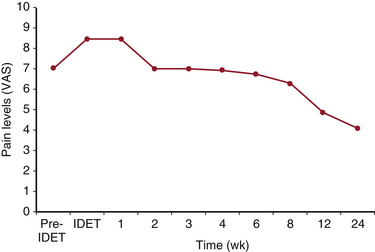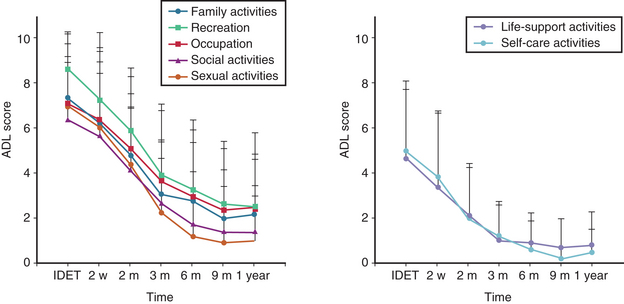Chapter 192 Intradiscal Electrothermy
Low back pain affects up to 80% of the U.S. population at least once in their lifetime.1–3 Although many cases of acute low back pain are self-limiting, resolving within 12 weeks, there is a recurrence rate of 20% within 6 months and an overall recurrence rate of 70% to 90%.1,4 In approximately 5% of patients, low back pain becomes chronic and disabling.5 Thus, chronic low back pain is the most common cause of disability between the ages of 45 and 65.3,6
Low back pain presents a diagnostic challenge, as only 10% to 20% of cases are attributable to a precise anatomic cause.7 There is poor correlation between symptoms, imaging findings, and physiologic changes. However, it has been estimated that about 40% of chronic low back pain originates from the intervertebral disc.8 Kuslich et al. demonstrated concordant pain on direct stimulation of the outer anulus of in vivo intervertebral discs, supporting the role of the disc as a “pain generator.”9 With degeneration theorized to be the underlying cause, the mechanism of discogenic pain has been pursued recently in clinical and basic research. Pathologic neoinnervation, nociceptive sensitization, biomechanical alteration, and internal anular fissuring/disruption have been implicated as possible mechanisms.
Treating chronic discogenic low back pain has been difficult. Medication and aggressive nonoperative treatment, such as physical therapy, often fail to improve function or to reduce pain significantly. In the past, individuals with continued pain and disability after initial therapy were treated with conservative pain management therapy or surgical intervention. Discectomy and fusion can have a 40% failure rate, particularly with multiple degenerative disc levels, in addition to the risk of complications, surgical morbidity, and prolonged recovery.10,11 As another option, less invasive intradiscal interventions have been the subject of much clinical and basic research since 1997, when Saal and Saal proposed intradiscal electrothermal therapy (IDET).12
IDET targets the intervertebral disc that is thought to be the pain generator, often aided by provocative discography. Under conscious sedation, a thermal coil is introduced into the dorsal aspect of the anulus fibrosus, and an amount of thermal energy is delivered. Though the mechanism of action is unclear, it has been proposed that the heat applied may alter the collagen organization in the anulus and coagulate nociceptive fibers to improve biomechanical function and reduce pain.13
Discogenic Low Back Pain
Intervertebral discs are bordered by thin hyaline cartilage end plates of the superior and an inferior vertebral body. The nucleus pulposus is the core of the disc, consisting of type II collagen and elastin embedded in the gelatinous substance aggrecan, which is rich in hydrated proteoglycans.3 Encasing the nucleus is a dense ring of type I collagen known as the anulus fibrosus; it is highly organized into lamellae and maintained by fibroblast-like cells. The disc is avascular, though nutrients can diffuse from the marrow cavity of the adjacent vertebrae across the cartilaginous end plates. In the lumbar spine, intervertebral discs are about 40 mm in diameter and 7 to 10 mm in height.3
Degeneration of the intervertebral disc seems to be intimately linked to the loss of nuclear hydrostatic pressure. Fragmentation of proteoglycans in the nucleus leads to reduced hydrostatic pressure, fewer proteoglycans in the nucleus, and fewer proteoglycans adjacent to the cartilaginous end plates. End-plate subchondral sclerosis and calcification will occur and further reduce the nutrient flow to the disc.14 It has been proposed that the anulus delaminates and buckles inward when the nuclear hydrostatic pressure is lost, leading to collapse of the normal anular organization.13 Resultant internal mobility and shear stress can lead to fissuring of the anular wall.15
Fissuring of the anulus can be assessed by CT discography. Although CT discography is not generally the diagnostic test of choice for discogenic low back pain, provoked pain concordant with chronic symptoms and CT evidence of internal disc disruption can be helpful in determining the benefit of possible operative intervention.3 However, no class I studies exist that compare outcomes in patients with and without positive discography for either spine fusion or IDET.
MR imaging demonstrating a high-intensity zone on T2-weighted images correlates with painful fissured discs in 65% to 95% of individuals; however, MR has a sensitivity of less than 50% for predicting the presence of anular fissures.13,16–18
Pain resulting from degeneration may arise from the disc, the mechanical effect of the disc on an adjacent structure, and the inflammatory mediators that are present in the setting of a degenerated disc.3 The anterior aspect of the disc is sparsely innervated by perivascular nerve plexuses joining branches of the sympathetic trunk. The posterior aspect is innervated more densely, with nociceptive nerve endings containing substance P primarily arising from the sinovertebral nerve endings with contributions from the sympathetic trunk.13,19,20 Discogenic pain is primarily axial, though referred leg pain can occur from converging nociceptive fibers from the leg and from the sinovertebral nerve.21
Nociceptive fibers are generally present in the outer third of the anulus fibrosus, the posterior longitudinal ligament, and the cartilaginous end plates.22 In vivo studies have shown that the two most common pain generators are the posterior longitudinal ligament and the dorsal anulus fibrosus.20 However, a degenerated disc may undergo neoinnervation with small, unmyelinated nociceptive fibers growing deep into the anulus fibrosus and even into the nucleus pulposus.23,24 Furthermore, nociceptors undergo presensitization from granulation tissue and inflammatory substances, including phospholipase A2, interleukin-1, nitrous oxide, and metalloproteinase.25–27
The complex interplay between continued mechanical loading and neural properties, including neoinnervation and presensitization, underlies the development of chronic discogenic low back pain.13 This entity is distinct from pain due to nerve compression from protruding or herniated discs; it is the disc that is the pain generator owing to an internal derangement.13 Therefore, the target of intervention is the disc itself.
Intradiscal Electrothermal Therapy
Given the suboptimal results of surgical treatment, the difficulties of chronic pain management, and the widespread prevalence of degenerative disc disease, a minimally invasive treatment for chronic discogenic low back pain is appealing. Saal and Saal developed IDET in 1997, theorizing that the clinical benefits that are observed from heat-induced collagen alteration as performed in joint stabilization procedures could translate to the degenerated, painful intervertebral disc.12
Briefly, the IDET procedure targets a painful disc as identified on provocative discography. IDET can be performed under conscious sedation. With fluoroscopic guidance, a navigable thermal resistive heating coil is introduced into the outer portion of the anulus fibrosus in the region of an anular fissure as noted by imaging, typically in the dorsal anulus. The catheter should lie about 5 mm from the outer edge of the anulus for adequate heating of the inner and outer anulus.28 In practice, the final position of the catheter is generally the contralateral posterolateral outer anulus, then passing anteriorly parallel to the anular lamellae.28 The coil is heated gradually to achieve tissue temperatures that are adequate to disrupt hydrogen cross-linking in the collagen triple helix, 60°C to 65°C, and coagulate nerve endings more than 42°C.5,29 Saal and Saal give 60°C to 75°C as a target tissue temperature.13 Up to 40% of the time, a bilateral approach is necessary to address the entire posterior anulus. Intradiscal antibiotics are given as discitis prophylaxis.13
Course of Recovery
IDET typically causes a transient increase in pain that lasts 1 to 2 weeks. Within 6 to 12 weeks, significant pain improvement and reduced disability are reported (Fig. 192-1). Benefits seem to be enduring, with progressive improvement 1 to 2 years postprocedure.30,31 However, some reports suggest that a significant population that will revert to baseline after initial improvement (Fig. 192-2).32

FIGURE 192-1 Typical recovery curve as presented by Saal and Saal, based on their first 100 treated patients.
(Redrawn from Saal JA, Saal JS: Intradiscal electrothermal therapy for the treatment of chronic discogenic low back pain. Clin Sports Med 21[1]:167–187, 2002.)
Postprocedure Rehabilitation
Transient worsening of symptoms is expected after IDET. Avoiding bending, lifting, and prolonged sitting should be recommended initially postprocedure. A corset is recommended for 6 to 8 weeks. Patients can gradually increase activities to include low-intensity stretching and walking over the first 4 weeks. Floor stabilization exercises at 4 weeks can be encouraged. Waiting 6 months postprocedure is recommended for athletic activity. Box 192-1 lists guidelines for patients following the procedure.
BOX 192-1. Guidelines for Patients
Lifting: Limit 5 to 10 lb for the first 6 weeks.
No bending or twisting of the low back.
Housework: No bending or twisting for the first 6 weeks.
You will be wearing a lumbar corset for the first 6 to 8 weeks after your IDET.
Saal JA, Saal JS: Intradiscal electrothermal therapy for the treatment of chronic discogenic low back pain. Clin Sports Med 21(1):167–187, 2002.
Selection Criteria
Pain reduction and functional improvement from IDET are observed in 23% to 86% of individuals, but it is widely accepted that stringent inclusion criteria are necessary, given the large number of nonresponders that has been observed.30,33–35 Studies suggest that individuals with multilevel degenerative disc disease respond poorly to IDET, on the basis of improved study outcomes with selection criteria excluding severe multilevel disease.31,33,36 Another group presents a study demonstrating poor outcomes correlated to obesity, with only 10% benefiting from IDET.37
Kloth et al. recently published a review of IDET selection criteria and indications for use to achieve clinical benefit in 75% of patients.38 Criteria that may be used include the following:
• Persistent axial low back pain with or without leg pain and nonresponsiveness to 6 or more weeks of conservative care
• History consistent with discogenic low back pain (e.g., pain with lumbar motion, decreased sitting duration and tolerance) with a normal lower-extremity neurologic examination
• One to three desiccated discs seen on T2-weighted MRI with or without a high-intensity zone, with or without small, contained disc protrusion, with at least 50% remaining disc height
• Concordant pain with low-pressure provocative discography (<50 psi above opening pressure) without discordant pain at pressures greater than 50 psi
• Posterior anular disruption (radial or concentric fissuring) on postdiscography CT images38
Exclusion Criteria
Contraindications presented by Kloth et al. include the following38:
• Severe disc degeneration at the affected lumbar level(s) as evidenced by greater than 50% disc height loss on plain anteroposterior and lateral lumbar radiographs and/or sectional imaging
• Extruded or sequestered herniated nucleus pulposus at the affected level(s)
• Previous lumbar back surgery (e.g., laminectomy, discectomy, or fusion) at the affected level(s)
• IDET performed within the last 6 months at the same level








